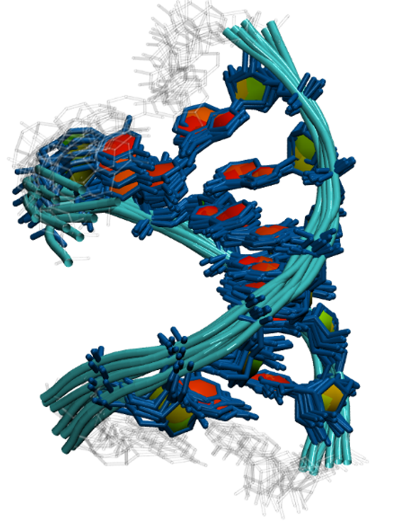IBBR Researchers Develop New Methods for RNA Structure Determination, Aiding Development of New Biotherapeutics

August 26, 2019 - Ribonucleic acid (RNA) is a biomolecule widely known as the “messenger” molecule of cells. RNA is emerging as a new platform for biopharmaceutical development, which until recently has been focused on protein-based therapeutics. RNA drugs are in clinical trials for the treatment of lung cancer and melanoma, and infections caused by hepatitis B, influenza, and Zika viruses. In August 2018, the FDA approved the first RNA interference (RNAi) drug in the US; Onpattro® treats the polyneuropathy caused by a hereditary disease called hATTR amyloidosis.
RNA chains fold into complex and flexible shapes based on their sequence. Since the shape of biomolecules (known as “higher order structure”) is critical to function, continued development of RNA-based therapeutics will require scientists to develop methods for reliably measuring the shapes and movements of these dynamic biomolecules. IBBR researcher Dr. Christina Bergonzo and IBBR Fellow Dr. Alexander Grishaev (both NIST Research Chemists) recently published two papers describing their work to improve the accuracy of RNA structures determined using a major technique of structural biology called nuclear magnetic resonance (NMR) spectroscopy.
Translating experimental data into structures requires mathematical modeling functions called force fields, which describe the way important chemical components of molecules work together in large, dynamic structures like proteins and RNA. It is important to use RNA-specific force fields since RNA’s chemical characteristics are quite distinct from proteins. For example, RNA has many negative charges which are shielded by water and ions in the environment, so Bergonzo and Grishaev developed and applied advanced force fields that include descriptions of individual water and salt molecules.
By cross-validating their refined structures against experimental NMR data, Bergonzo and Grishaev demonstrate that improved force fields lead to more robust assessment of the structure and flexibility of RNA. “The use of our advanced force fields yields many structures that, when combined, help incorporate the known flexibility of nucleic acids into representative models,” Bergonzo explains. “Our work on small RNA structures can be used as a springboard to the larger RNA systems that are the focus of drug design and development pipelines.”
The articles describing this work appear in Journal of Biomolecular NMR (doi: 10.1007/s10858-019-00236-6) and Journal of Structural Biology (doi: 10.1016/j.jsb.2019.07.001).
-----
Inquiries: communications@ibbr.umd.edu
